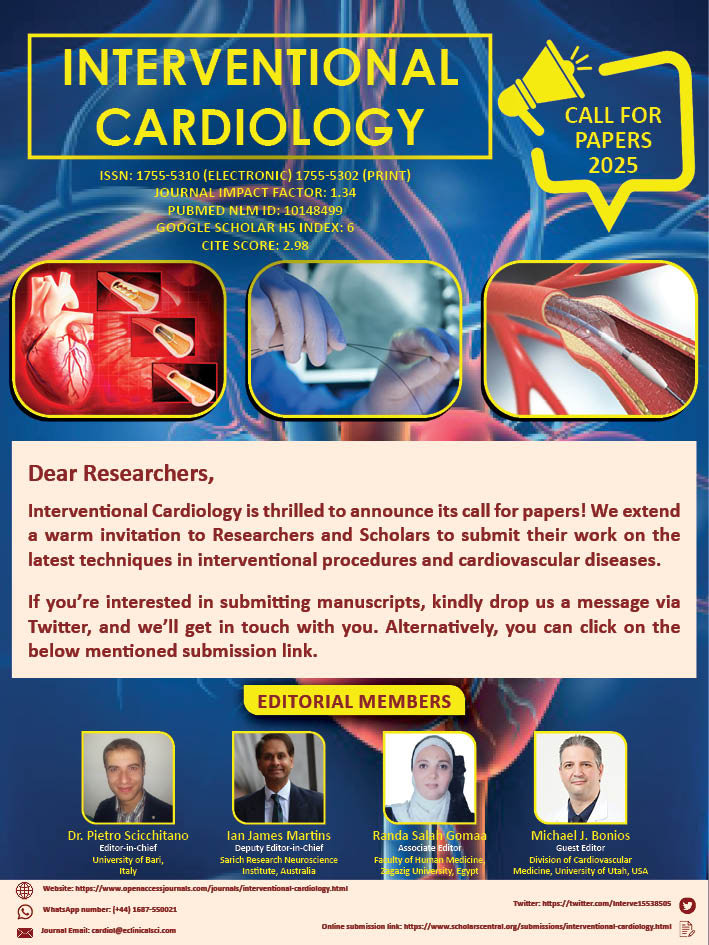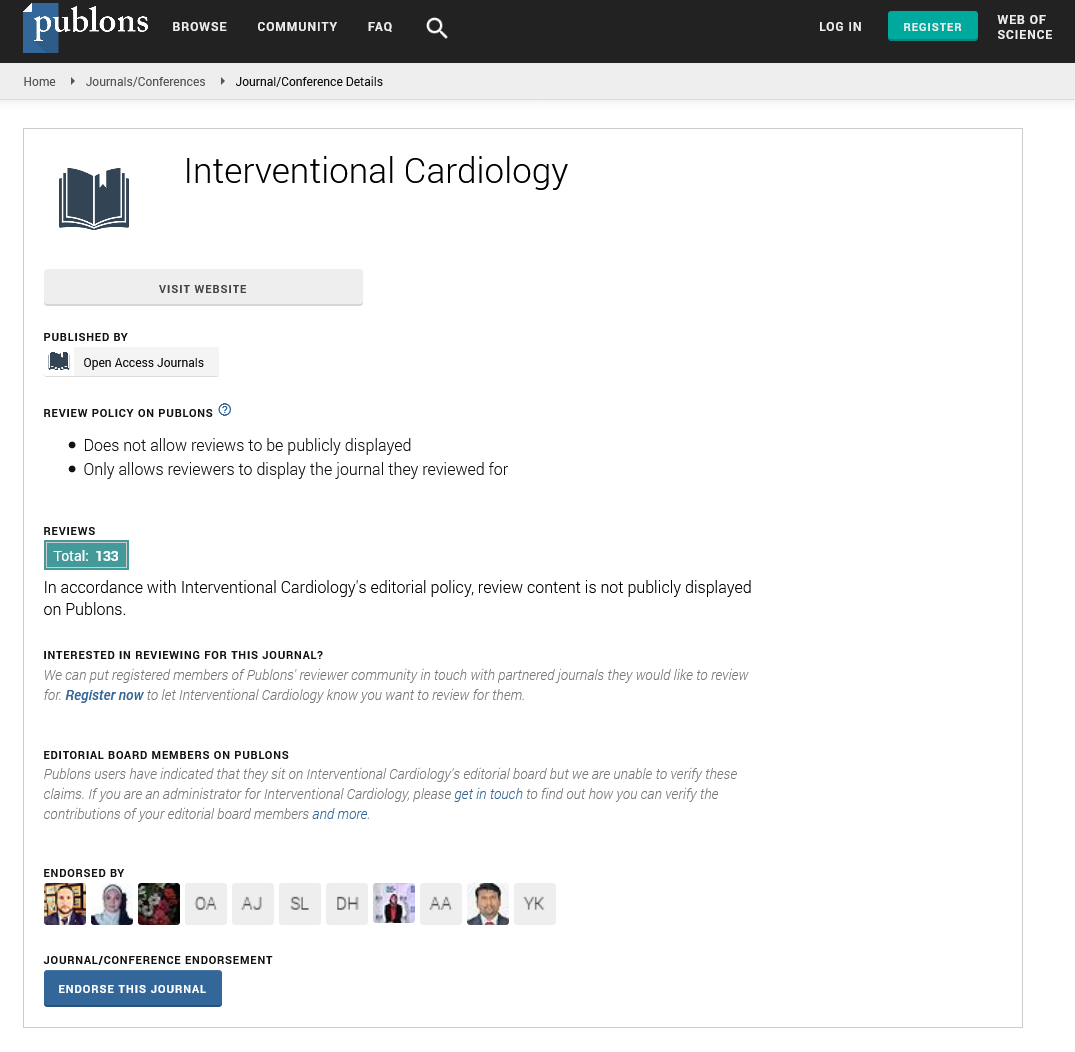Short Communication - Interventional Cardiology (2025) Volume 17, Issue 3
The Hidden Spark: Gitelman Syndrome Triggering Polymorphic Ventricular Tachycardia
- Corresponding Author:
- Jamal Yusuf
Department of Cardiology, Govind Ballabh Pant Hospital, New Delhi, India
E-mail: jamalyusuf72@yahoo.com
Received date: 03-Apr-2025, Manuscript No. FMIC-25-167805; Editor assigned: 05-Apr-2025, PreQC No. FMIC-25-167805 (PQ); Reviewed date: 19-Apr-2025, QC No. FMIC-25-167805; Revised date: 26-Apr-2025, Manuscript No. FMIC-25-167805 (R); Published date: 03-May-2025, DOI: 10.37532/1755- 5310.2025.17(3).1015
Keywords
Gitelman syndrome • Polymorphic ventricular tachycardia • Hypokalemia; Hypomagnesemia • Arrhythmia • SLC12A3 mutation
Description
A 60-year-old woman, with no history of cardiac disease or exposure to QT-prolonging medicines, presented with a two-week history of recurrent syncope and palpitations. Her baseline Electrocardiogram (ECG) showed normal sinus rhythm with normal QTc. However, during symptom episodes, continuous telemetry captured polymorphic VT, each initiated by R-on-T phenomena, causing hemodynamic instability and requiring synchronized cardioversion.
Initial laboratory work-up revealed severe electrolyte disturbances: serum potassium 2.7 mEq/L, serum magnesium 0.9 mg/dL, and metabolic alkalosis. High-sensitivity troponin levels were within normal limits. Transthoracic echocardiography showed normal biventricular function and no structural abnormalities. Cardiac positron emission tomography excluded infiltrative or inflammatory diseases such as sarcoidosis or myocarditis. Computerized tomography of the abdomen ruled out primary hyperaldosteronism and other adrenal pathologies. Renal function was normal, and renin-aldosterone levels were not elevated. Urine studies revealed inappropriate renal wasting of potassium and chloride, renal magnesium loss, and low calcium excretionâ typical findings in GS. Genetic testing confirmed compound heterozygous mutations in SLC12A3, establishing the diagnosis.
Management began with synchronized cardioversion and continuous intravenous replacement of potassium chloride and magnesium sulfate. Despite partial improvement, the patient experienced multiple episodesâat least fiveâof recurrent VT over the next 72 hours, requiring further cardioversion. Oral potassium and magnesium supplements were introduced, along with low-dose amiloride (5 mg daily), a potassium-sparing diuretic that helps preserve electrolytes in GS. Within 48 hours of starting this regimen, serum potassium and magnesium stabilized within normal ranges (K+: 3.8â4.2 mEq/L; Mg2+: 1.8â2.0 mg/dL), and no further VT episodes were documented. The patient was monitored in-hospital for five days, then discharged on oral supplementation and amiloride, with scheduled outpatient follow-up [1,2].
This case highlights several important clinical insights First, electrolyte disturbances in GSâparticularly hypokalemia and hypomagnesemiaâcan directly impair myocardial repolarization, leading to early after-depolarizations and triggering polymorphic VT even without QTc prolongation, as seen in this patient. QT prolongation, while common in GS, is not required for arrhythmogenesis [3â7]. Second, this case underscores the incomplete reliability of ECG markers alone. Despite absence of QTc prolongation, the patient experienced life-threatening arrhythmias, emphasizing the need for electrolyte evaluation in arrhythmia work-up. Third, initial management focused on electrolyte repletion demonstrated transient benefit but did not prevent VT recurrence. True stabilization occurred only after addition of amiloride and sustained oral supplementation. This supports a strategy of early identification and correction of underlying electrolyte derangements, rather than immediate referral for invasive therapies such as Implantable Cardioverter- Defibrillator (ICD) placement. Fourth, awareness of GS as a reversible cause of arrhythmia is critical. Previous case reports have shown diverse presentations, from torsades de pointes to ventricular fibrillation, with treatment strategies ranging from electrolyte replacement to combined replacement plus ICD implantation [8â10]. Our patient avoided ICD placement, reinforcing that aggressive metabolic therapy may suffice. Fifth, the case supports a multidisciplinary approach: coordinated care between cardiology, nephrology, and genetics ensures accurate diagnosis, electrolyte monitoring, and long-term follow-up to prevent recurrence. Supportive lifestyle adviceâadequate dietary electrolyte intake and avoidance of salt-depleting medicationsâis also essential.
Conclusion
In patients with structurally normal hearts presenting with unexplained polymorphic VT and persistent hypokalemia or hypomagnesemia, GS should be a key diagnostic consideration. Prompt identification and comprehensive correction of electrolyte disturbances using potassium and magnesium supplementation alongside potassium-sparing diuretics can resolve arrhythmic events and may preclude the need for ICD implantation. Confirming SLC12A3 mutations through genetic testing not only establishes the diagnosis but also guides for lifelong management and enables early detection in at-risk family members. A collaborative, multidisciplinary strategy is essential for optimizing patient outcomes and preventing future episodes.
References
- Simon DB, Nelson-Williams C, Bia MJ, et al. Gitelmanâs variant of Bartterâs syndrome: Inherited hypokalemic alkalosis with hypomagnesemia and hypocalciuria. N Engl J Med. 335(8):555-561 (1996).
- Blanchard A, Bockenhauer D, Bolignano D, et al. Gitelman syndrome: Consensus and guidance from a kidney disease: Improving global outcomes (KDIGO) controversies conference . Kidney Int. 91(1):24-33 (2017).
- Foglia PE, Bettinelli A, Tosetto C, et al. Cardiac work-up in primary renal hypokalemia-hypomagnesemia (Gitelman syndrome). Nephrol Dial Transplant. 19(6):1398-1402 (2004).
- Scognamiglio R, Negut C, Calò LA, et al. Myocardial perfusion defects in Bartter and Gitelman syndromes. Eur J Clin Invest. 38(12):888-895 (2008).
- Al Banna R, Husain A, Al-Ghamdi B. Ventricular arrhythmia and tachycardia-induced cardiomyopathy in Gitelman syndrome. BMJ Case Rep. 12(12):e232086 (2019).
- Yusuf J, Gautam A, Jain S, et al. Decoding Gitelman syndrome in a structurally normal heart with polymorphic ventricular tachycardia: A case report. Heart Rhythm Case Rep. 11(3):206209 (2025).
- Idries IY, Azhar M, Yadav R, et al. Heartâs dangerous symphony: Torsade de pointes unleashed by Gitelman syndrome-induced hypomagnesemia. Cureus. 15(8): e44464 (2023).
- Nakane E, Kono T, Sasaki Y, et al. Gitelmanâs syndrome with exercise-induced ventricular tachycardia. Circ J. 68(5):509-511 (2004).
- Vanga SR, Annapureddy C, Biria M, et al. Monomorphic outflow tract ventricular tachycardia: Unique presenting manifestation of Gitelmanâs syndrome. J Atr Fibrillation. 2(4):229 (2010).
- Pachulski RT, Lopez F, Sharaf R, et al. Gitelmanâs not-so-benign syndrome. N Engl J Med. 353(8):850-851 (2005).

